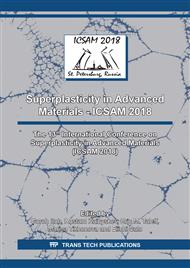[1]
Grässel O, Krüger L, Frommeyer G, Meyer L W, High strength Fe-Mn-(Al, Si) TRIP/TWIP steels development - properties- application, Inter. J. Plasticity, 16 (2000) 1391-1409.
DOI: 10.1016/s0749-6419(00)00015-2
Google Scholar
[2]
Gutierrez-Urrutia I, Raabe D, Multistage strain hardening through dislocation substructure and twinning in a high strength and ductile weight-reduced Fe-Mn-Al-C steel, Acta Mater. 60 (2012) 5791-5802.
DOI: 10.1016/j.actamat.2012.07.018
Google Scholar
[3]
B. B. He, B. Hu, H. W. Yen, G. J. Cheng, Z. K. Wang, H. W. Luo, M. X. Hua, High dislocation density–induced large ductility in deformed and partitioned steels, Science 357 (2017) 1029-1032.
DOI: 10.1126/science.aan0177
Google Scholar
[4]
Suihe Jiang, Hui Wang, Yuan Wu, Xiongjun Liu, Honghong Chen, Mengji Yao, Baptiste Gault, Dirk Ponge, Dierk Raabe, Akihiko Hirata, Mingwei Chen, Yandong Wang, Zhaoping Lu, Ultrastrong steel via minimal lattice misfit and high-density nanoprecipitation, Nature. 544 (2017).
DOI: 10.1038/nature22032
Google Scholar
[5]
Raabe D, Roters F, Neugebauer J, Gutierrez-Urrutia I, Hickel T, Bleck W, Mayer J. A, initio-guided design of twinning-induced plasticity steels. MRS Bull. 41 (2016) 320-325.
DOI: 10.1557/mrs.2016.63
Google Scholar
[6]
Dini G, Ueji R, Najafizadeh A, Monir-Vaghefi S M, Flow stress analysis of TWIP steel via the XRD measurement of dislocation density, Mater. Sci. Eng A 527 (2010) 2759-2763.
DOI: 10.1016/j.msea.2010.01.033
Google Scholar
[7]
H. P. Karnthaler, The study of glide on {001} planes in f.c.c. metals deformed at room temperature, Phil. Mag. A 38 (1978) 141-156.
DOI: 10.1080/01418617808239225
Google Scholar
[8]
Lee J H, Holland T B, Mukherjee A K, Direct observation of Lomer-Cottrell Locks during strain hardening in nanocrystalline nickel by in situ TEM, Sci. Rep. 3:1061 (2013) 1-6.
DOI: 10.1038/srep01061
Google Scholar
[9]
Kumar N, Goel S, Jayaganthan R, Brokmeier Heinz-Günter, Effect of Grain boundary misorientaton, Deformation Temperature and AlFeMnSi-phase on Fatigue Life of 6082 Al alloy, Mater. Charact. 124 (2017) 229-240.
DOI: 10.1016/j.matchar.2017.01.002
Google Scholar
[10]
Pierce D T, Jiménez J A, Bentley J, Raabe D, Witting J E, The influence of stacking fault energy on the microstructural and strain-hardening evolution of Fe–Mn–Al–Si steels during tensile deformation, Acta Mater. 100 (2015) 178-190.
DOI: 10.1016/j.actamat.2015.08.030
Google Scholar


